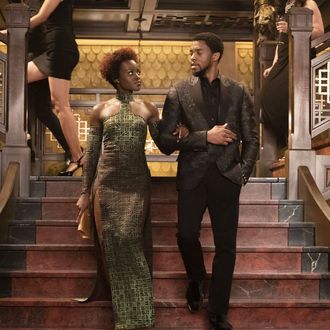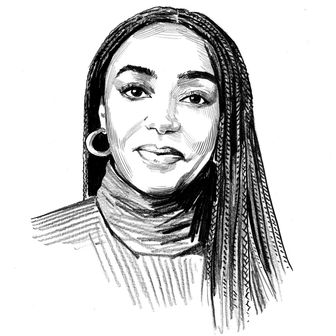
Before Black Panther, the last time America saw images of black royalty in a major Hollywood movie was Coming to America in 1988. So Ruth E. Carter had a real challenge ahead of her when it came to designing the Afro-futurist costumes worn in the movie by actresses Lupita Nyong’o, Angela Bassett, and Danai Gurira. Their hair would be inspired by traditional African styles, but the clothes requires a lot more imagination.
If anyone in Hollywood was right for the task, though, it was Carter. The costume designer for Malcolm X, What’s Love Got To Do With It, Selma, and practically every Spike Lee film, she’s responsible for how we envision several generations of black heroes on screen. The designer talked to the Cut about the themes she brings to every project, what makes Black Panther special, and how she hopes women will feel when they leave the theater.
How did you go from helping backstage at plays to dressing superheroes?
As a child, I had a sewing machine desk in my room, and I would try to figure out how to sew with those old Singer patterns. By the time I got to college as a theatre student, I felt really comfortable creating costumes because I knew about breaking down a script and characterization. I loved spending hours creating the face of the person in my mind and subsequently what they were wearing.
I moved out to Los Angeles after school to pursue my career in theatre and it wasn’t until I met Spike Lee that things connected. He saw that I was trying to express myself with costumes, doing everything I could making $120 a week because I knew it fulfilled me.
You never worked on movie sets before working with Spike Lee. How did that form your career as a costume designer?Spike was very much a leader for us — he wanted to be conscious, to be Afro-futurist, and to make sure we created an image of black people in cinema that was positive and more realistic than what we had been seeing. It wasn’t about any kind of gangs, any kind of commercialization. He was from Brooklyn and wanted show this hub of cultural experiences. That was my inception into the arts of black people, the arts of the African diaspora, the arts of expression and self pride.
How did you handle the responsibility of creating the images of black superheroes that have never existed?
Ryan Coogler and I agreed that it had to be spectacular. It had to be a feast for the eyes, with different wardrobes for different tribal councils. The nation of Wakanda needed to represent a forward-thinking and rich culture, but also I needed to project a look of royalty. I didn’t want it to look like our tribal leaders were in the dark ages.
I was also under a lot of pressure to create something that didn’t look like appropriation or stereotypical. Everything had to appeal to my fashion sense and be modern — not space-age, the way movies always use a diamond pattern on somebody’s robe or put points on their sleeves and a big collar. It’s just like your iPhone: each version progressively got sleeker and a little bit better. I felt like Wakanda was a place that was a little bit ahead, but not way-in-the-stratosphere ahead. It’s just enough ahead for us to relate to it.
What was the biggest inspiration for the costumes?
What made me excited was studying the ancient indigenous people of Africa because it’s easy to translate a lot of the things that they wore into a model that feels fresh today. Everything they wore had a story behind it: certain crowns only worn by certain royalty, certain hats only worn by married women.
The women in this film are dressed impeccably. What kind of takeaways did you want people to have when they saw them?
I did research years back in Virginia studying colonial Williamsburg, and back then hierarchy was key in clothing. When Thomas Jefferson was president, his wife had all her clothes made by a group of slaves. When I created Ramonda, mother of T’Challa (Angela Bassett’s character), I knew as the queen that I wanted her to have a faction of people who were highly educated in technology and that would create her costumes and create her look for her. So I gave her a Zulu hat that I had 3D printed and I gave her a custom-made gold breastplate with matching neckpiece so that she could represent Wakanda as the queen in a real regal way.
Danai Gurira’s character, who is the leader of the Dora Milaje, a team of women warriors, I gave her gold neck rings and the rest of the warriors wore silver. Every little piece infused some kind of cultural story.
What do you want women of color to see when they see the women in Black Panther?
As women of color, we lack images that we can fantasize about. I feel like women maybe spend too much time with fashion magazines trying to emulate fashion models that they can’t emulate because they don’t have the same body type. They’ll never wear those clothes the way that the models wear them in Vogue magazine, so here is a way to accept and acknowledge the black female form.
When you put on your shapely garments and your beautiful color palette, and you wrap your hair and you put that knot at the top, you feel a sense of pride. Even though Wakanda is made up, it is still a part of the continent from which our ancestors came, and it gives people a context with which to think of people of color in a positive way — instead of in a radical militant way or a negative way. We’re making Africa chic again, and I hope when women see that, they go, “Tomorrow when I go to work, I’m going to wrap my hair up!”
This interview has been edited and condensed.


